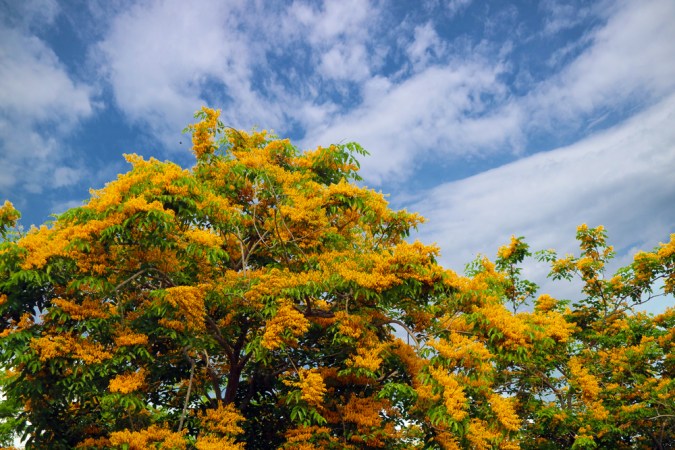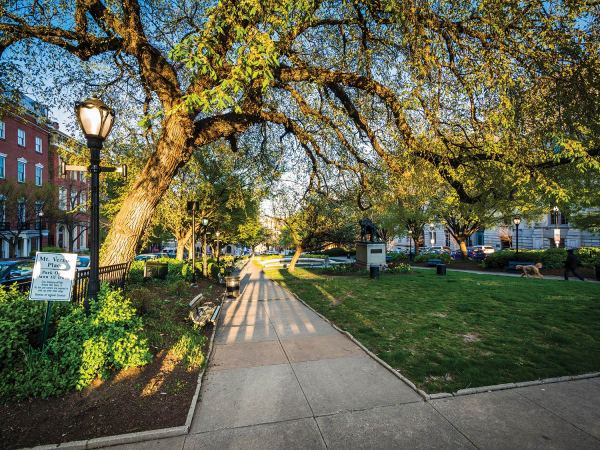

There’s a lot of high-tech proposals out there to avert climate catastrophe: sucking up carbon and storing it underground, carpooling to work in flying taxis, and even converting methane to carbon dioxide. But one of the most important actions is also one of the most mundane: planting trees.
In fact, the International Panel on Climate Change in its 2018 special report says that we need to plant around 1 billion hectares (or about 2.5 billion acres) of trees—in addition to cutting our emissions—to stop the planet from warming beyond 1.5 ºC. A number of programs have sprouted up to commit countries to restoring their forests and hopefully upping their carbon-storing capacities.
But where should they all go?
This week, two studies try to answer that question. The first, published Thursday in Science, addresses the IPCC goal head on by trying to determine if there is room for that many trees in the first place.
To find this out, scientists studied satellite images of tree cover across natural preserves and considered how the soil and climate of a given area influenced tree growth. After analyzing how those factors affect trees in preserves, they used that information to predict how well trees would grow in other areas across the globe. Based on the soil and climate of a site, their model could predict tree growth.
The study reports that even if we avoid land that’s currently developed or used for agriculture, there’s still 0.9 billion hectares of area available for tree-planting—an area about the size of the United States. This includes degraded forest lands, logged areas, and grasslands. Half of these lands are found in six countries: Russia, the United States, Canada, Australia, Brazil, and China.
“Restoring ecosystems and planting trees is not something new,” says Jean-Francois Bastin, ecologist at ETH Zurich, who notes that there are many international agreements on tree-planting. “Our data can guide [commitments] to improve by making them be more realistic. Sometimes they can be bolder, by doing more than they pledge, but we saw that countries were pledging an area that overcame their current capacities.” And countries with the space aren’t aggressive enough.
In the Bonn Challenge, an effort led by Germany and the International Union for Conservation of Nature, 10 percent of countries have committed to planting more trees then feasible, while 43 percent aren’t pulling their weight, by committing to far less than restorable area that exists, according to the Science study. That puts the Bonn Challenge’s ultimate goal to plant 3.5 million hectares of trees by 2030 at risk.
It’s a seductively simple idea, that we can stop climate change just by filling in all these landscapes with trees. But there’s a lot more to it if we want to plant trees right.
At the behest of environmentalists, we’ve already been planting trees for a long time. We have more trees on the planet today than 30 years ago. In the past 20 years, China has restored more than 108,000 square miles of forests. But 45 percent of commitments under the Bonn challenge are monoculture plantations, according to an April report in Nature. That means we’re planting vast acres of the same tree species, often fast-growing varieties like eucalyptus that can be harvested for paper. Not only do these forests not store as much carbon as natural forests, they don’t foster good habitat for native species—a blow to biodiversity.
Bastin is doing his part to correct our wayward tree-planting tendencies, and he’s finding ways to bring others along with him. “Restoring the ecosystem needs to be done by respecting the local composition of species and the local biodiversity,” he says. Government officials, NGO leaders, and others can use his maps to see how much tree canopy a given area can support, but they still need to identify the best trees to plant. Toward that end, Bastin says he’s helping build a database of common species for each degraded area.
Pedro Brancalion is a forestry professor at the University of São Paulo, and the leader author of another new study, published Wednesday in Science Advances. Where Bastin and his colleagues focused on carbon storage, Brancalion and his co-authors detail other reasons for valuing forests. The new methods also consider the unique costs of rainforest restoration, like how much potential profit will be lost by returning an area from agriculture back to its natural state. With a focus on tropical rainforests, it identified “hotspots” in 15 countries—over 100 million hectares of land in Central and South America, Africa, and Southeast Asia—and proposed strategies for their restoration.
A typical hotspot has these three qualities: the existing forest is heavily degraded or gone, it’s home to many species, and it’s close to where people live. Not only can these areas store carbon and provide habitat, healthy forests clear water of sediments and pollutants, a boon to humans.
To identify these locations, the scientists overlaid data on the potential for trees to benefit biodiversity, climate change mitigation, climate change adaptation, and water security. They picked out the 10 percent of areas with the most overlap in benefits and lowest costs associated with restoring forests. “The opportunity for restoration is heterogeneously distributed over space,” says Brancalion. “There needs to be a knowledge basis for supporting these initiatives, and that’s what we tried to do.”
Of course, just having a tool that lets you assess all the benefits of trees doesn’t directly translate to trees being planted. “We basically have to transform [forest restoration] into a more economically viable activity,” says Brancalion.
To that end, he’s investigated some solutions. In a study in Brazil, he found that if landowners can restore a plot of land with a mix of native trees and eucalyptus, then the money they make from eucalyptus timber would offset much of the costs of restoration. He adds that if there was a way to pay landowners for providing ecosystem services—carbon storage, clean water and air—that could help change current incentives, too. Restoring natural forests, then, is part finding creative ways to make money off restored land and part changing how we value restoration by recognizing the tangible benefits that these ecosystems provide.
It’s a daunting task, but it will only get more challenging as the climate warms. As the Science study shows, climate change will scale back the potential area for trees. But we need to move carefully if we’re to realize the intended benefits. It’s not just about planting trees, but restoring actual forests.















